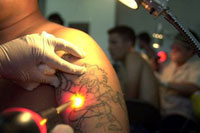Women suffer from sexual discrimination even when it comes to tattoos
Women having tattoos are much more likely to have second thoughts about their permanent body markings, a new study showed. The researchers determined that women may be discriminated for their tattoos, which often leads them to believe that their decision to have a tattoo was a mistake.

Study author Myrna L. Armstrong, a professor in the school of nursing at Texas Tech University 's Health Sciences Center, in Lubbock, Texas, believes that a tattoo is never a problem for men. As a rule a man never receives utterly negative comments about his tattoos no matter how ugly those tattoos may look.
"This isn't a problem for men. Society supports men, because tattoos are related to a macho image, so we don't question it. But for women, having a tattoo seems to be a transgression of gender boundaries," the scientist said.
Women make up to 65 percent of the tattoo market. Many of those who decide to remove their markings say that they made their tattoos between the ages 16 and 23. Women decide to have tattoos because of the feeling to feel unique and distinctive. However, women decide to remove their tattoos because they cause them embarrassment.
Men remove their tattoos too, of course. However, the percentage difference is rather significant at this point: 69 percent women vs. 31 percent men.
Many women say that they are forced to cover up their tattoos with clothing, bandages or make-up to avoid negative reactions in public.
While tattoos are considered permanent, it is possible to remove them. Complete removal, however, may not be possible (although many doctors and laser practitioners make the claim that upwards of 95% removal is possible with the newest lasers, especially with black and darker colored inks), and the expense and pain of removing them typically will be greater than the expense and pain of applying them. Some jurisdictions will pay for the voluntary removal of gang tattoos. Gangs will often involuntarily remove gang tattoos, from a person who leaves the gang. Pre-laser tattoo removal methods include dermabrasion, salabrasion (scrubbing the skin with salt), cryosurgery, and excision which is sometimes still used along with skin grafts for larger tattoos.
Tattoo removal is most commonly performed using lasers that react with the ink in the tattoo, and break it down. The broken-down ink is then absorbed by the body, mimicking the natural fading that time or sun exposure would create. This technique often requires many repeated visits to remove even a small tattoo, and may result in permanent scarring. The newer Q-switched lasers are said by the National Institute of Health to result in scarring only rarely, however, and are usually used only after a topical anesthetic has been applied. The NIH recognizes five types of tattoo; amateur, professional, cosmetic, medical, and traumatic (or natural). Areas with thin skin will be more likely to scar than thicker-skinned areas. There are several types of Q-switched lasers, and each is effective at removing a different range of the color spectrum. This laser effectively removes black, blue, purple and red tattoo pigment. New lasers like the Versapulse & Medlite laser treat these colors & yellow and green ink pigment, typically the hardest colors to remove. Black is the easiest color to remove.
Also worth considering is the fact that some of the pigments used (especially Yellow #7) are known to break down into toxic chemicals in the body when attacked by light. This is especially a concern if these tattoos are exposed to UV light or laser removal; the resulting degradation products end up migrating to the kidneys and liver. Laser removal of traumatic tattoos may similarly be complicated depending on the substance of the pigmenting material. In one reported instance, the use of a laser resulted in the ignition of embedded particles of firework debris.
Subscribe to Pravda.Ru Telegram channel, Facebook, RSS!

